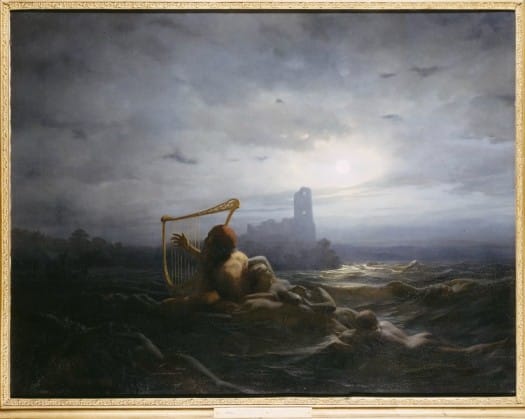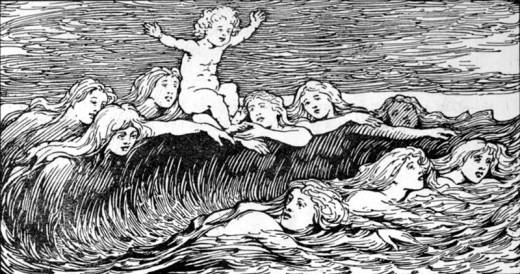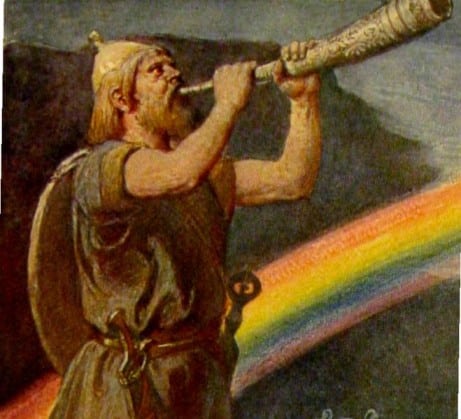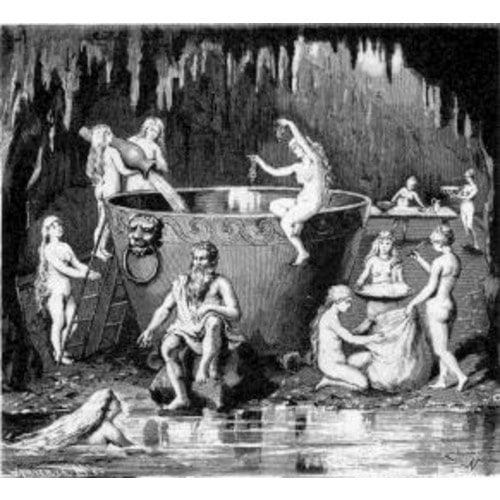Järnsaxa is a jötun, daughter of Aegir and Ran as well as one of nine sisters, personifications of ocean waves. She is known to have been the consort of Thor with whom she had Magni. However, she is also likely to be one of the nine sisters to have had an affair with Odin. That affair later resulted in the birth of the Aesir god Heimdall.
Järnsaxa is shrouded in some mystery. Moreover, there are a couple of things where there is some confusion about her. In this post I’ll both share what I believe is correct and explain why as well.
My position is that, either there are two separate jötun giantesses named Järnsaxa, as well as two separate groups of nine jötun sisters, or what I state as facts are true. However, as is often the case with Norse mythology there are contradictory sources that make it less clear cut. I’ll do my level best laying it out below. If you have a comment or thoughts on this, please do share in the comments at the bottom!
Short Facts
Tribe: Jötun
Daughter of: Aegir and Ran (most likely)
Sister to: Gjolp, Greip, Eistla, Eyrgjafa, Ulfrun, Angeyja, Imth and Atla
Co-wife or Consort of: Thor and Odin
Mother of: Magni (with Thor), Heimdall (with Odin)
Meaning of name: Järnsaxa means Iron-dagger in Old Norse
Origins and Family
Based on the available source, my understanding is that she is one of nine daughters of Aegir, the jötun ruler of the oceans and his wife Ran, herself a goddess, or possibly a jötun. As a jötun, Järnsaxa hails from the realm of Jotunheim, home to the giants in Norse mythology. However, it’s likely she might live in her parents home of Aegirheim, at the bottom of the sea.
Her relationship with Thor, one of the main Aesir gods, later resulted in the birth of Magni. Despite being a source for discussion, I believe she is one of Heimdall’s nine mothers mentioned in the Poetic Edda poem The Lay of Hyndla. As such she, and her sisters, had an affair of sorts with Odin, who is the uncontested father of Heimdall.
The mysteries of Järnsaxa in the Old Texts
When trying to unravel the contradictions regarding Järnsaxa, I need to point out something about Norse mythology. The Norse myths lived, developed and changed over the course of hundreds of years. The poems of the Poetic Edda were composed, then later written over several hundred years.
Then when Snorri Sturluson sat down to write the Prose Edda, including the often quoted Skáldskaparmál and Gylfaginning, another couple of hundred years had passed. The result is that we do often find contradictions, information that is missing or references made to stories unknown to us.
This takes us to the story of Järnsaxa, her origins, affairs and children.
The Daughters of Aegir and Ran
The daughters of Aegir and Ran are listed a couple of times in the Skáldskaparmál part of the Prose Edda. In addition, reference is made both to “Aegir’s daughters’ ‘ and to “sisters of Kolga’ ‘ in the Poetic Edda poem The First Lay of Helgi Hundingsbane.
Skáldskaparmál LX – On names of the sea
The daughters of Aegir and Rán are nine, and their names are recorded before: Himinglæva ( Transparent, That through which one can see the heaven), Dúfa (The Pitching One), Blódughadda (Bloody-Hair), Hefring (Riser), Udr (Frothing Wave), Hrönn (Welling Wave), Bylgja (Billow), Dröfn (Foam-Fleck), Kólga (Cooling One).
The First Lay of Helgi Hundingsbane
- So did it sound, | when together the sisters
Of Kolga struck | with the keels full long,
As if cliffs were broken | with beating surf,
. . . . . | . . . . . - Helgi bade higher | hoist the sails,
Nor did the ships’-folk | shun the waves,
Though dreadfully | did Ægir’s daughters
Seek the steeds | of the sea to sink.

So, Aegir and Ran have nine daughters, personifications of the waves, but Järnsaxa is not named as one of them.
The Nine mothers of Heimdall
However, Järnsaxa is mentioned in the Poetic Edda poem Hyndluljoth (‘The Lay of Hyndla) as one of nine sisters, all mothers to Heimdall.
The Lay of Hyndla
- One there was born | in the bygone days,
Of the race of the gods, | and great was his might;
Nine giant women, | at the world’s edge,
Once bore the man | so mighty in arms. - Gjolp there bore him, | Greip there bore him,
Eistla bore him, | and Eyrgjafa,
Ulfrun bore him, | and Angeyja,
Imth and Atla, | and Järnsaxa.
The names of these sisters can be translated to something like this:
- Gjölp means “yelper” or “screamer.”
- Greip means “grasper” or “gripper.”
- Eistla is likely derived from “eistr,” meaning “ice” or “frost.” This name could be interpreted as “icy” or “frosty.”
- Eyrgjafa is a compound of “eyr” (gravel, sand) and “gjafa” (giver). This name could be translated as “gravel giver” or “sand giver.”
- Ulfrun: Ulfrun is a compound of “ulfr” (wolf) and “run” (secret, rune). This name could be translated as “wolf rune” or “wolf secret.”
- Angeyja: Angeyja is likely derived from “angr” (grief, sorrow) and “eyja” (island). This name could be translated as “island of sorrow” or “island of grief.”
- Imth: The meaning of Imth is not well-known, but it could be related to “im” (around, about) or “imm” (great, mighty). It could potentially mean “great” or “mighty.”
- Atla: Atla is a female name derived from “atl” (water, river). The name could mean “water” or “river.”
- Jarnsaxa: Jarnsaxa means “iron-sax” or “iron-knife.”
Note that several of these names are either clearly, or could be understood be related to water and the ocean. As interesting is the illustration that was made for this poem in 1908. Based on that, their understanding was that the nine sisters of the Lay of Hyndla, are the same as the nine daughters of Aegir and Ran.

The mothers of Heimdall from the Prose Edda
In the Prose Edda, Gylfaginning Ch VIII Snorri states that Heimdall is indeed the son of nine mothers, who were sisters.
“Heimdal is the name of one, also called the white-Aesir. He is great and holy; born of nine maidens, all of whom were sisters. He hight also Hallinskide and Gullintanne, for his teeth were of gold. His horse hight Gulltop (Gold-top). His dwelling is a place called Himinbjorg, near Bifrost.”
Then in Skáldskaparmál, XVI – On how to periphrase Loki, Snorri gives different ways for Skalds to name Loki. In one such example, by the poet Úlfr Uggason, Heimdall is said to have nine mothers.
“Even as Úlfr Uggason sings here:
The famed rainbow’s defender,
Ready in wisdom, strives
At Singasteinn with Loki,
Fárbauti’s sly offspring;
The son of mothers eight and one,
Mighty in wrath, possesses
The Stone were Loki comes:
I make known songs of praise.
Here it is written that Heimdallr is the son of nine mothers.”
Two groups of Nine sisters in Norse mythology?
My belief is that the nine daughters of Aegir and Ran are the same as the nine mothers of Heimdall. I find it highly unlikely that there would be two unconnected groups of nine sisters. Moreover, that both of them would have names more or less related to the ocean or waves seems equally unlikely.
Why they are named differently is impossible to say, but I think that is the simple explanation. Across the hundreds of years that these poems cover, names were changed, or adapted,. However, the mythological characters they represented were the same.
Play Norse Quiz
Is this article making you even more curious about Norse gods and goddesses? You can satisfy your curiosity by playing a fun Norse mythology quiz. This way, you can test your knowledge about Norse gods and goddesses, as well as fill in some gaps. Good luck and have fun playing!
How much do you know about Järnsaxa’s relationship with Odin? Can you name all of their children? Play this game and find out! Don’t forget to try our other games as well!
Heimdall and Magni – Sons of Järnsaxa, Odin and Thor
With Järnsaxa being one of the daughters of Aegir and Ran, she is also one of the mothers of Heimdall. The father of Heimdall is not contested anywhere, and as one source says it in Skáldskaparmál VII, he is the son of Odin.
“VIII – On how to periphrase Heimdallr
Úlfr Uggason composed a long passage in the Húsdrápa on that legend, and there it is written that they were in the form of seals. Heimdallr also is the son of Odin.”
This also makes a lot of sense considering that Thor’s mother is Jord, the personification of the earth. Odin, one of the first of the Aesir, fathered his sons Thor and Heimdall by unions with the personifications of the earth and the sea.
Similarly, as there is no doubt of who Heimdall’s father is, who the parents of Magni are is well documented.
In Skáldskaparmál ch. XVII Magni is said to be the son of Thor and Järnsaxa. Then in ch. XXI one kenning given about Thor’s wife Sif is co-wife of Järnsaxa. So the relationship between Thor and her is well established, and Magnis parentage is not contested.
XVII – Haustlöng and Thor’s Duel with Hrungnir
Then Magni came, son of Thor and Járnsaxa: he was then three nights old. He threw Hrungnir’s foot off Thor, and spoke: ‘See how bad it is, father, that I came so late: I had struck this giant dead with my fist, I think, if I had met with him.’
XXI – On how to periphrase Sif
“How should Sif be paraphrased? By calling her Wife of Thor, Mother of Ullr, Fair-Haired Goddess, Co-Wife of Järnsaxa, Mother of Thrúdr.
Järnsaxa and Thor: An Unlikely Pair
Despite the ongoing conflict between the Aesir gods and the jötnar, Järnsaxa and Thor share a passionate and tumultuous relationship. Their union represents the duality of creation and destruction, order and chaos, which is a recurring theme in Norse mythology. Through her connections to both Thor and Odin, Järnsaxa is linked to two of the most powerful gods in the Norse pantheon, and her role as a mother to Magni and Heimdall further highlights her significance in the mythology.
Magni, the Son of Thor and Järnsaxa
Magni, the son of Thor and Järnsaxa, stands out as an impressive figure in Norse mythology. Being the offspring of the god of thunder as well as a powerful giantess, he inherits immense strength, which makes him one of the strongest gods in the Norse pantheon. His name, meaning “Strength” in Old Norse, attests to his extraordinary power.
In the myth involving the death of the giant Hrungnir, one of Thor’s most fearsome foes, Magni plays a crucial role. Following a fierce battle between Thor and Hrungnir, Thor finds himself pinned under the lifeless body of the giant. Unable to lift Hrungnir’s massive corpse, the other gods watch as Magni, merely three days old, effortlessly moves the giant’s body and frees his father.
This display of strength and heroism earns Magni immense admiration from Thor, who rewards his son with the giant’s powerful horse, Gullfaxi. Despite Odin’s disapproval of the gift, believing such a prize should be reserved for the gods, Magni’s possession of Gullfaxi cements his status as a formidable god.
Magni is fated to survive the cataclysmic events of Ragnarök, the Norse apocalypse. Rising from the ashes of the old world he will join his half-brother Modi, another son of Thor. Together they inherit their father’s mighty weapon, Mjölnir. Magni and Modi will aid in rebuilding the world after the devastation caused by Ragnarök, ensuring the legacy of Thor and Järnsaxa endures into the new era.
Järnsaxa and Odin: A Mysterious Connection
Järnsaxa’s relationship with Odin is less well-documented than her connection to Thor. As the chief of the Aesir gods, Odin is renowned for his wisdom, pursuit of knowledge, and numerous consorts and affairs.
Interestingly, Järnsaxa, a giantess from Jotunheim, is only one of the nine sisters who together mothered Heimdall, one of the most important deities in Norse mythology. This complex relationship between Odin and the nine sisters, including Järnsaxa, remains enigmatic, highlighting the intricate web of connections between the gods and the giants, who are often depicted as adversaries.
Heimdall, the Son of Odin and Järnsaxa (and her sisters)
Heimdall, the offspring of Järnsaxa and Odin, holds a pivotal position in Norse mythology. As the son of the chief of the Aesir gods and a powerful giantess, Heimdall possesses unique attributes, setting him apart from other gods. He is famous for his extraordinary senses, particularly his sharp sight and hearing, which enable him to detect impending danger from vast distances.

Heimdall’s birth is cloaked in mystery, as he is said to have been born of nine mothers, all giantesses. This unusual origin story further underscores Heimdall’s connection to both gods and giants, reflecting the complex relationships between these two groups in Norse mythology.
During the final battle of Ragnarök, Heimdall is fated to confront the trickster god Loki. The two adversaries, both possessing cunning and intelligence, are destined to kill each other in a ferocious struggle, symbolizing the ultimate clash between order and chaos.
As the son of Odin and Järnsaxa, Heimdall’s role in Norse mythology spans a wide range of responsibilities and abilities. From his duties as the watchman of the gods to his involvement in the creation of human society, Heimdall’s significance in the Norse pantheon is both powerful and diverse.
Järnsaxa’s Legacy and Influence
Järnsaxa’s legacy in Norse mythology is primarily defined by her relationships with Thor and Odin, as well as her roles as the mother of Magni and Heimdall. As the consort of two of the most powerful Aesir gods, Järnsaxa demonstrates the complex relationships between the gods and the giants. The two races are often portrayed as enemies, but they share ancestors, and often relationships as well. Her position as a mother to two essential deities cements her importance in the Norse pantheon.
Her name, “Iron-dagger,” symbolizes her strength and the untamed nature of the jötnar, reinforcing the theme of duality in Norse mythology, where the forces of order and chaos are intricately intertwined.
Last thoughts on Järnsaxa
Järnsaxa, the jötun consort of Thor and mother to Magni and Heimdall, represents the chaotic and untamed forces of nature in Norse mythology. Her relationships with Thor and Odin underscore the duality of creation and destruction, order and chaos, which is a central theme in Norse mythology. Despite her limited role in the myths, Järnsaxa’s connections to two of the most powerful gods in the Norse pantheon and her roles as the mother of Magni and Heimdall make her an essential figure in the mythology.
I hope my reasoning seems sound and is easy to follow. Do please reach out if you find I have missed something that would change it.
FAQs
Järnsaxa is a powerful giantess (jötun) from Jotunheim, one of the nine daughters of Aegir and Ran.
Järnsaxa’s name translates to “Iron-sword” or “Iron-dagger,” emphasizing her strength and ferocity.
Järnsaxa is the mother of Magni, a powerful god and son of Thor, and Heimdall, an important deity born of Odin and Järnsaxa along with her eight sisters.
Järnsaxa is seen as a giantess, originating from the realm of Jotunheim, the home of the giants in Norse mythology.
Järnsaxa plays a crucial role as a link between gods and giants, highlighting the intricate connections and relationships between these two groups in Norse mythology.
Featured Image Credit: thorofasgardia via Instagram

